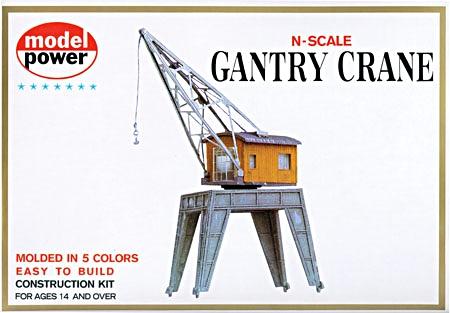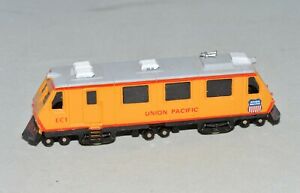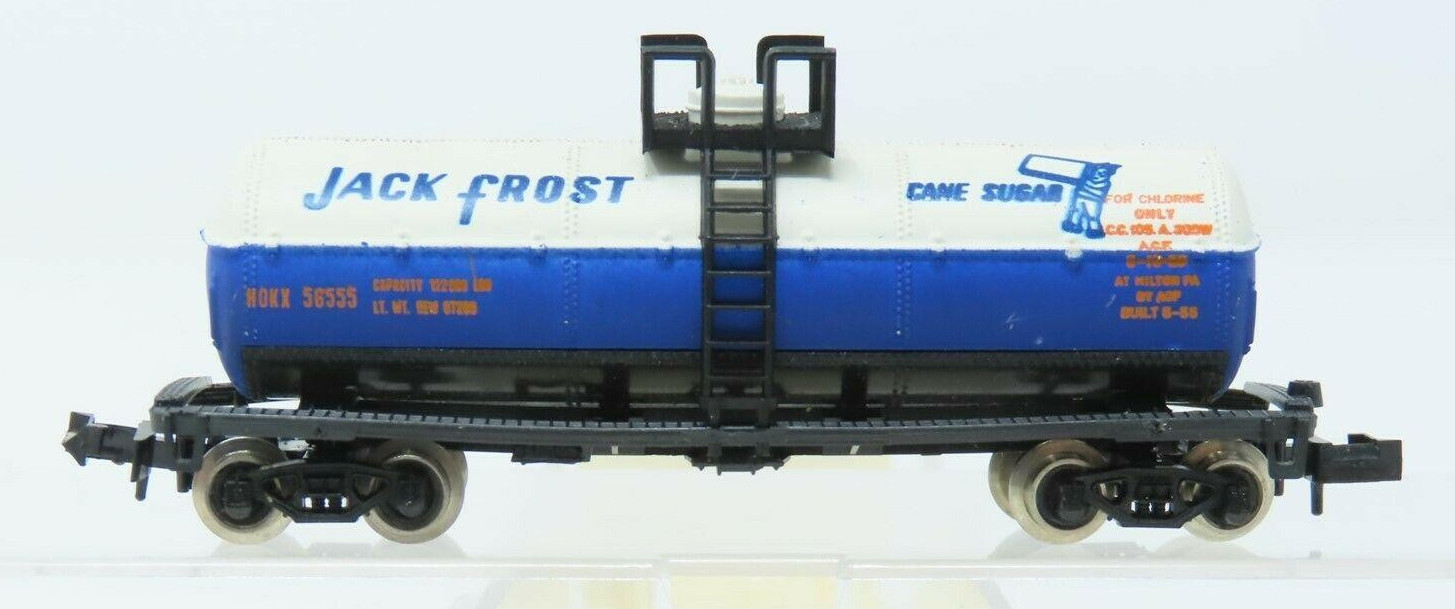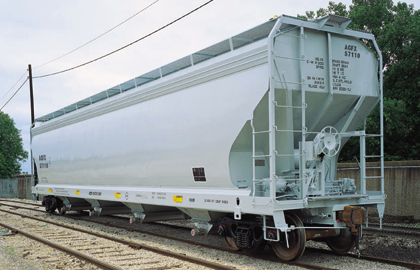Model Information: This model was originally introduced in 1993. It is somewhat similar to the earlier Roco/Atlas produced 3700-series model which was still available in the 1990s when this new model became available. The earlier models can be distinguished from this one because they are stamped either "Austria" or "Atlas USA" on the underframe. The later models can also be identified by the angled stirrups at each end (as opposed to squared off ones on the Austrian tooling). Lastly, the Chinese versions have several ridges along the side towards the roof-line in a 'washboard' pattern.
This new Chinese production model was specifically identified as modeling the ACF 5250 c.f. Centerflow hopper When this model appeared in the 1994 Atlas catalog it was on the next page after the earlier tooling (apparently many of the old models were still in the warehouse). The new ones were marketed as 'ACF 4-Bay Centerflow® Hopper - All New Mold Work!" as opposed to the older models which were labeled as "ACF 4-Bay Centerflow® Covered Hopper". Atlas' model represents the post-1971 version of the ACF 5250 4-Bay Covered Hopper Car that was used by railroads and private shippers across North America.
This new Chinese production model was specifically identified as modeling the ACF 5250 c.f. Centerflow hopper When this model appeared in the 1994 Atlas catalog it was on the next page after the earlier tooling (apparently many of the old models were still in the warehouse). The new ones were marketed as 'ACF 4-Bay Centerflow® Hopper - All New Mold Work!" as opposed to the older models which were labeled as "ACF 4-Bay Centerflow® Covered Hopper". Atlas' model represents the post-1971 version of the ACF 5250 4-Bay Covered Hopper Car that was used by railroads and private shippers across North America.
Prototype History: Contemporary 2-bay covered hoppers, like ACF's Centerflows, were 100-ton cars designed to haul dense loads, like cement. Their larger 3 and 4-bay brethren, while usually still having 100 ton capacities, were designed for lighter-density loads, like grain or flour. Their sizes had to do with the fact that a low-density product like grain will "cube out" the cubic capacity of a smaller 2-bay car way before you hit the cars' tonnage rating. Conversely, load a 3 or 4-bay covered hopper to its cubic maximum with a dense product like cement, and you'll wind up with a seriously overloaded car tonnage wise. In short, keep the smaller 2-bay cars for heavy commodities, and keep the larger cars for lighter loads like grains, sugar, flour, etc.
Road Name History:  Augustus Eugene Staley (25 February 1867 - 26 December 1940) founded a sales company for food starch in Baltimore in 1898. On 6 November 1906, he incorporated his starch business that he had created in Baltimore, Maryland in order to start the production of food starch. In 1909 Mr. Staley purchased an inoperative cornstarch plant in Decatur, IL. He paid $45,000 and spent three years rebuilding and upgrading the plant with capital that he had raised from stockholders. The factory began processing on March 12, 1912.
Augustus Eugene Staley (25 February 1867 - 26 December 1940) founded a sales company for food starch in Baltimore in 1898. On 6 November 1906, he incorporated his starch business that he had created in Baltimore, Maryland in order to start the production of food starch. In 1909 Mr. Staley purchased an inoperative cornstarch plant in Decatur, IL. He paid $45,000 and spent three years rebuilding and upgrading the plant with capital that he had raised from stockholders. The factory began processing on March 12, 1912.
The company has produced many famous household brands including Staley Pancake and Waffle Syrup, Sta-Puf fabric softener, and Sta-Flo liquid starch. The two latter brands were subsequently sold to Dial.
A. E. Staley Manufacturing was one of the largest processors of corn in the United States, second only to the Archer Daniels Midland Corporation, also based in Decatur, Illinois. It also processed soybeans under a partnership agreement with Archer Daniels Midland at its Decatur, Illinois plant. Archer Daniels Midland, through a subsidiary, owned 7.4% of A.E. Staley and often time, Archer Daniel Midland would assist A.E. Staley with filling corn syrup order for CPC international when the company was in short supply of product. Both companies also had joint ventures producing corn sweeteners in Central America.
In 1985, A. E. Staley purchased CFS Continental, a wholesale grocery company, for $360 million. A. E. Staley stated a need to diversify away from bulk food processing. After the acquisition, A. E. Staley changed its name to Staley Continental.
In 1988, British company Tate & Lyle acquired 90% of A. E. Staley for $1.42 billion. Prior to the purchase, Tate & Lyle announced that it planned to sell CFS Continental to SYSCO, another wholesale grocer, for $700 million to help fund the acquisition. In 2000, Tate & Lyle acquired the remaining 10% of A. E. Staley.
From Wikipedia

The company has produced many famous household brands including Staley Pancake and Waffle Syrup, Sta-Puf fabric softener, and Sta-Flo liquid starch. The two latter brands were subsequently sold to Dial.
A. E. Staley Manufacturing was one of the largest processors of corn in the United States, second only to the Archer Daniels Midland Corporation, also based in Decatur, Illinois. It also processed soybeans under a partnership agreement with Archer Daniels Midland at its Decatur, Illinois plant. Archer Daniels Midland, through a subsidiary, owned 7.4% of A.E. Staley and often time, Archer Daniel Midland would assist A.E. Staley with filling corn syrup order for CPC international when the company was in short supply of product. Both companies also had joint ventures producing corn sweeteners in Central America.
In 1985, A. E. Staley purchased CFS Continental, a wholesale grocery company, for $360 million. A. E. Staley stated a need to diversify away from bulk food processing. After the acquisition, A. E. Staley changed its name to Staley Continental.
In 1988, British company Tate & Lyle acquired 90% of A. E. Staley for $1.42 billion. Prior to the purchase, Tate & Lyle announced that it planned to sell CFS Continental to SYSCO, another wholesale grocer, for $700 million to help fund the acquisition. In 2000, Tate & Lyle acquired the remaining 10% of A. E. Staley.
From Wikipedia
Brand/Importer Information: In 1924 Stephan Schaffan, Sr. founded the Atlas Tool Company in Newark, New Jersey. In 1933 his son, Stephan Schaffan, Jr., came to work for his father at the age of sixteen. Steve Jr. built model airplanes as a hobby and frequented a local hobby shop. Being an enterprising young man, he would often ask the owner if there was anything he could do to earn some extra spending money. Tired of listening to his requests, the hobby-store owner threw some model railroad track parts his way and said, "Here, see if you can improve on this".
In those days, railroad modelers had to assemble and build everything from scratch. Steve Jr. created a "switch kit" which sold so well, that the entire family worked on them in the basement at night, while doing business as usual in the machine shop during the day.
Subsequently, Steve Jr. engineered the stapling of rail to fiber track, along with inventing the first practical rail joiner and pre-assembled turnouts and flexible track. All of these products, and more, helped to popularize model railroading and assisted in the creation of a mass-market hobby. The budding entrepreneur quickly outgrew the limitations of a basement and small garage operation. Realizing they could actually make a living selling track and related products, Steve and his father had the first factory built in Hillside, New Jersey at 413 Florence Avenue in 1947. On September 30, 1949, the Atlas Tool Company was officially incorporated as a New Jersey company.
In 1985, Steve was honored posthumously for his inventions by the Model Railroad Industry Association and was inducted into the Model Railroad Industry Hall of Fame in Baltimore, Maryland. In addition, Steve was nominated and entered into the National Model Railroad Association Pioneers of Model Railroading in 1995.
In the early 1990s, the Atlas Tool Company changed its name to Atlas Model Railroad Company, Inc.
In those days, railroad modelers had to assemble and build everything from scratch. Steve Jr. created a "switch kit" which sold so well, that the entire family worked on them in the basement at night, while doing business as usual in the machine shop during the day.
Subsequently, Steve Jr. engineered the stapling of rail to fiber track, along with inventing the first practical rail joiner and pre-assembled turnouts and flexible track. All of these products, and more, helped to popularize model railroading and assisted in the creation of a mass-market hobby. The budding entrepreneur quickly outgrew the limitations of a basement and small garage operation. Realizing they could actually make a living selling track and related products, Steve and his father had the first factory built in Hillside, New Jersey at 413 Florence Avenue in 1947. On September 30, 1949, the Atlas Tool Company was officially incorporated as a New Jersey company.
In 1985, Steve was honored posthumously for his inventions by the Model Railroad Industry Association and was inducted into the Model Railroad Industry Hall of Fame in Baltimore, Maryland. In addition, Steve was nominated and entered into the National Model Railroad Association Pioneers of Model Railroading in 1995.
In the early 1990s, the Atlas Tool Company changed its name to Atlas Model Railroad Company, Inc.
Item created by: RoadRailer on 2017-02-03 12:39:11. Last edited by CNW400 on 2020-09-01 11:23:41
If you see errors or missing data in this entry, please feel free to log in and edit it. Anyone with a Gmail account can log in instantly.
If you see errors or missing data in this entry, please feel free to log in and edit it. Anyone with a Gmail account can log in instantly.










